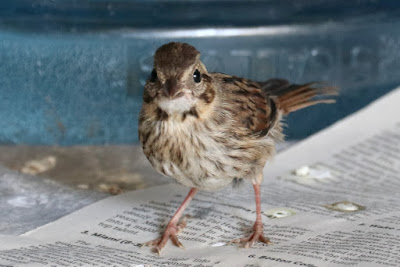Once I’d seen all three babies eating on their own from dishes, I could take them out to the fledging tent in my detached four-car garage. This is a great setup because the tent is totally protected from the winds we get on the ridgetop, which destroyed my first and best fledging tent, crumpling it up like so much Kleenex. (Luckily there were no birds inside at the time.) I leave the garage door open, and one end of the tent gets sunshine much of the day. My little inmates can sunbathe, splash in their shallow baths, sleep on high branches, and race around on the floor of the tent, which is about 10' wide x 15' long x 8' tall. They can hear birds singing and watch what’s going on in the wild birds' world, and imagine themselves flying free out there. But at night, I can close the garage door and know no predator is going to get them.
Bob, Day 27
I can see beyond the cute.
Chipmunks are the bane of my existence as a songbird rehabilitator and gardener, too. They’re super smart, conniving, and bloodthirsty, and they’ll gladly pounce on naïve baby birds and make a meal of them. In the first two days after his release, I saved Dustin (2020's song sparrow client) multiple times from becoming chipmunk lunch. My worst moment was seeing a chipmunk jump him and tussle with him. I lunged at the animal, and Dustin shook himself off and resumed hopping and scratching as if it warn’t no big deal. He didn't even fly away! It was up to me to chase the damn rodent out of the flowerbed so Dustin could go on being bait. He was slow, and they were sharp, but he eventually got the message, and began to listen to his natural vigilance.
I was taking no chances with this trio, so I decided to train them to a pedestal before releasing them. It wasn’t easy. Most sparrows are by nature ground feeders (it’s pretty rare to get a song sparrow on a platform or hanging feeder). So I started with a low iron table, perhaps 1.5’ off the ground. It took awhile, but they eventually accepted it. I then tried placing their dishes on a tray atop a pedestal, looking for an extra foot or two of height for their safety. Nothing doing. They wouldn’t land on the metal tray. I sat back and studied the situation. I placed the metal table, on which they were used to landing, atop the pedestal. Success! I had them eating 3' off the ground!
Slowly, they’d transitioned to accepting lots of millet and mixed canary seed as well as mealworms, and that was great, because it would be a lot easier for me to keep them in millet than mealworms, with most of the birds in my yard wise to the delicious offerings I put out for my rehab clients.
Ball, left, with Baby, Day 27, in the fledging tent. These two hung out constantly in the tent. Bob was not interested in their company.
Ball, left, with Baby, Day 27.
Baby, left, and Ball discover a termite in the tent.
This was not a good thing for the termite.
Once they were used to flying up to the pedestal to feed, I switched to using a large flat board on top of it. This would be their feeder upon release. All these changes took place over the week and a half they were in the tent. Once they were reliably feeding on the board-topped pedestal, there was nothing to hold them back. It was September 17, and they were 27 days old. I had chosen this day for release because Margaret Morse Nice, Ohio song sparrow guru and author of one of the finest single-species studies ever done, wrote that the oldest young she’d ever observed being fed by parents was 27 days old. If M.M. Nice says it, it's true!
That's Margaret Nice in the middle, aged 60 in 1953. She looks like someone I'd love to bird with! Raised five kids while conducting the best study to date of any vertebrate anywhere, ever. Wouldn't it be a hoot to time travel and hand her a pair of Swarovski binoculars to use? We use the tools that we are given.
If you'd like to learn more about Columbus resident and exemplary behavioral scientist Margaret Morse Nice, here's a good blogpost: https://blog.nature.org/science/2016/08/08/battles-song-sparrows-scientific-outsider-changed-study-birds-ornithology-margaret-morse-nice/























5 comments:
It's so fun to read these details, Julie. I admire your patience and fortitude...I know from your previous rehab posts the kind of time and energy all of this takes. But I'll bet that there is also great delight and joy (and relief) in seeing them fly off to their real home. And they are so danged cute! Thank you for caring for those little ones from those of us who don't have the know how.
This post so brightens my day! Thank you for bringing so much joy into my life -- and, no doubt, into the sparrows' lives.
I love reading the saga of the song sparrows. Thank you for all your effort and care in their behalf.
You give us so many details that I feel like I was right there standing beside you the whole time. And I actually got the larval instar reference! Thank you for caring for the little sparrows.
Post a Comment